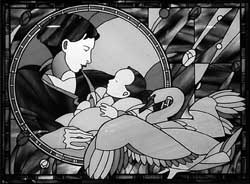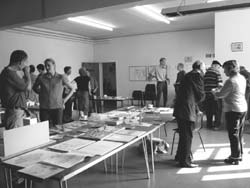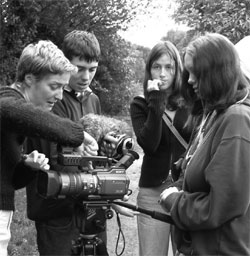PASW Regional Newsletter: Spring 2003
Focus On Current Projects & Issues
Art in Gloucestershire Hospitals NHS Trust
Specialist arts in healthcare consultants Willis Newson recently took over the management of Arts in Trust, the arts programme of Gloucestershire Hospitals NHS Trust.
The team - Jane Willis, Lorna Trupec and Joanna Espiner - are currently developing a comprehensive arts strategy for the Trust, while also working with lead artist Simon Ryder on an exciting commissioning strategy for the new PFI £30 million hospital development underway at the Gloucestershire Royal.
The Trust already has a collection of over 500 works of arts, some of which have been commissioned as part of new buildings or major refurbishments across its sites. There are also two gallery spaces showing temporary exhibitions at Cheltenham General Hospital.
The new team now hopes to develop the programme further, securing a Percent for Art Policy, incorporating other artforms and integrating the programme more closely with the Trust’s core business of healthcare.

Mother and Child. Artists: Nick Robertson and Jim Turton
Photo: Anthony Barclay
In the early days of arts in healthcare, the integration of the arts in hospital settings was often limited to commissioning and purchasing works of art to beautify hospital buildings and improve the patient environment. While this is still valid and vital, Arts in Trust is open to using all artforms - interior and landscape design, digital and multimedia, music, performance, creative writing, dance, puppetry, storytelling etc - to address a range of different needs across the whole community of the Trust.
“We believe that good health is about more than the absence of disease and that the arts can play a valuable role in the healing process”, says Jane Willis, director of Willis Newson.
“At its best, the process of working with artists can involve enquiry, lateral thinking, problem solving, communication and self-expression. As well as being used to enhance the healthcare environment, the arts can be a powerful tool in facilitating communication, community building, play and relaxation, learning and understanding”.
“The benefits of projects extend far beyond material outcomes - stained glass, sculpture, poems and songs. They might include increased self-confidence, renewed enthusiasm for one’s job and a fresh perspective on one’s situation. They often cannot be fully measured until long after a project has finished,” she adds.
The team is actively seeking to work in partnership with artists and arts providers across the region to realise its programme.
“By working collaboratively, we hope that both the arts and the hospital communities will benefit,” says Jane.
“As experienced arts in healthcare facilitators, we are well positioned to support artists to work in healthcare - which as well as being an exciting, rewarding and stimulating environment, can also be challenging, difficult and stressful for those new to it. We therefore aim to explore opportunities to develop training and mentoring programmes for artists new to the field”.
Artists or arts organisations interested in working with Arts in Trust should contact Willis Newson: email: at [email protected] or on 0117 924 7617
Notes
Gloucestershire Hospitals NHS Trust comprises Gloucestershire Royal Hospital, Cheltenham General Hospital, Standish Hospital, Tewkesbury and Winchcombe Hospitals, Wheatstone Day Hospice and Delancey Assessment and Rehabilitation Hospital.
Anne Greer, the former arts co-ordinator at Gloucester Royal, has taken on the new role of Environment Co-ordinator at Gloucestershire Royal.
Wellspring Public Art Project
Wellspring is a new Healthy Living Centre that is being built in the heart of Barton Hill in East Bristol as part of the £50 million New Deal for Communities (NDC) regeneration programme in the area.
An integral part of the new building will be a series of artists’ commissions, including ceramic flooring (by Marion Brandis), a glass entrance (by Anne Smyth), entrance gates (by Julian Coode), a staircase (by Walter Jack) and signage (by Lucy Casson).

Meet the Artists Day, Sept 2002.
Photo: Georgina Holt
Part of the ethos of Community at Heart (the organisation managing the NDC programme) is to involve residents as fully as possible in the regeneration process. From the beginning of the public art project a group of residents have worked alongside the architects and Local Authority Public Art Officer to select the artists, advise the Lead Artist (Marion Brandis), agree the commissions and approve the designs.
In addition a larger number of residents are getting involved in the project through a programme of workshops which will help inform the artists’ designs.
By taking this approach we obviously hope that residents will have a greater sense of ownership of the Healthy Living Centre; but in addition we aim to have given a small number of people - with no previous experience of commissioning - invaluable skills in developing public art projects and working with artists.
Ruth Hecht, Arts Co-ordinator, Community at Heart
Art in the Landscape project in North Devon
Northern Devon Coast and Countryside Service has secured funding from LEADER +, South West Arts’ Regional Arts Lottery Programme, the Environment Agency, and South West Lakes Trust for a series of four pilot projects for the northern Devon region.

Braunton Youth Club Project. Artist Kirsty Waterworth working with Youth Club members.
Photo: Lisa Harty
The four projects, which will be completed by March 2004, are being developed and delivered in collaboration with a number of regional partners as part of the ‘Art in the Landscape’ initiative which follows on from the hugely successful ‘Art in the Travelling Landscape’ project delivered in collaboration with Sustrans, on the Tarka Trail. The development and delivery of this series of pilot projects will serve to demonstrate what can be achieved and the role the arts can play in rural regeneration. Both the two district councils, Torridge and North Devon together with Public Art South West and Sustrans have played a vital role in offering advice and support for this initiative.
Exeter based artist, Phil Power, will be producing work for a permissive footpath at Slade Reservoir near Ilfracombe. The artist/ architect team from Glasgow, Sans Facon, will be developing and creating a viewing structure at Velator Wetland near Braunton and Tavistock based artist, Kirsty Waterworth, will be working with young people from Braunton Youth Club on the production of artworks for the cycleway in Braunton. The fourth project involves local artist, Simon Heath, in working with residents from Westward Ho! on artworks that will be sited along the coastal path in Westward Ho!
Lisa Harty, Project Manager, on behalf of NDCCS
Sculpture in Bristol

The rich variety of public art adorning the city of Bristol - shortlisted for European Capital of Culture in 2008 - has been celebrated in a new book.
Entitled ‘Sculpture in Bristol’, Douglas Merrit’s book encompasses modern works such as the Zenith light feature in Millennium Square on Harbourside as well as the UK’s oldest public war memorial.
From the imperial scale of Rysbrack’s brass equestrian statue of King William III in the newly-restored Queen Square to the seated figure of a weather-beaten John Cabot on Narrow Quay, Bristol lives up to its reputation as a city of statues and monuments.
The last in a long line of sculptures recorded is that of the Hollywood movie star Cary Grant, born and brought up in Bristol and now commemorated in bronze by Graham Ibbeson.
While statues of famous people predominate, the regeneration of Bristol offers opportunities for more innovative examples of public art, such as the disarmingly realistic Jack Russell terriers outside the Millennium-funded attraction, Explore @ Bristol.
Andrew Kelly, Director of Bristol 2008, said: “Art is essential to cities. ‘Sculpture in Bristol’ provides inspiration to us all to create more public art.”
Ruth Wilmshurst, Bristol 2008
Penzance Passenger Transport Interchange scheme goes on-site.
After two years in the planning, the RALP-funded public art programme for the redevelopment of the Penzance Passenger Transport Interchange is set to be installed during March. The public art is intended to form a dramatic visual focus and celebrate a sense of arrival for more than 1.6m passengers a year who use this this busy 'end of the line' terminal.
As well as marking the end of the national railway network, the Passenger Interchange is the main terminus for local bus services, ferry and helicopter links to the Isles of Scilly and the Mount's Bay leg of the National Cycle Route.
The programme has been developed and project managed by Truro-based public art and regeneration consultancy, Cornish Project Delivery. The overall artistic concept for the site was developed by Lead Artist David Kemp, working with Gordon Young. A black and white theme has been chosen for the site, reflecting the Cornish identity embodied in St. Piran's flag, and a paving scheme using the design of the Cornish flag will form the central motif of the site. The flag, made from 8,006 recycled black granite and white marble cores, both by-products of the monumental memorial industry, is set in a black and white sand and cement matrix. It features a map of West Cornwall integrated into it, the coastline outlined in stainless steel with the Cornish names of individual towns, villages and landmarks being denoted with letters being cut into the cores. A sandblasted finish will create a non-slip surface.
St Just artist David Kemp's own distinctive contribution to the site will be two steel 'Directional Sculptures'. These have been fabricated by Penzance Dry Dock and completed at Longdowns (near Penryn) where they are being given a shot-blasted, galvanized and painted finish, using a high-build alkyd system, in black and white. Six metres high to the top-masts with a rake to give them a dynamic quality, the sculptures are set in long low benches, faced in local granite, which will provide informal seating for waiting passengers outside the station.
The contemporary maritime feel is cleverly integrated into the sculptures with a large black and white PZ, the identifying mark of the local fishing fleet. The sails on the top-masts reflect the distinctive cross of St. Piran's flag. Seen against the traditional elevation of the railway station, the gantry and signals at the top of the mast make reference to Penzance's position as first and last, the beginning and end of the Great Western Railway.
The bench tops by Teena Gould, will be ceramic, and are being constructed in rectangular and curved blocks using a white firing clay. Each of the 140 blocks is hand moulded in a plaster mould. The surface will be patterned with shell imprints, Celtic patterns, references to the standing stones and leaf imprints amongst other devices. Once made, the pieces will be decorated with a black firing slip made from china clay mined in Cornwall. After initial firing, a variety of black and white glazes will be used on the blocks with references to the patterns made from the sea spray, ripples on sand and, of course, the ever-changing waves and open skies. The adjacent planters, designed by landscape architect John Morland, will also be decorated with ceramic inserts to complement the benches.
Geoff Swallow, Principal, Cornish Project Delivery
Redruth Economic Arts Project nears Objective One bid stage
Cornish Project Delivery, and Mor design, a Falmouth-based landscape design company, have been working together on the development of a strategy for the integration of public art in the physical and economic regeneration of Redruth, on behalf of the Redruth Economic Arts Partnership. The strategy is complete, and an Objective One bid, supported by a detailed business plan, is currently in preparation for the implementation of an ambitious £1.4m public art programme over the first 3 years of the strategy.
Although the initial 3 year programme will focus on Redruth, key to the strategy's success in terms of Objective One funding will be the adoption of the strategy by the Camborne-Pool-Redruth Urban Regeneration Company (URC). The strategy proposes the setting up of a Public Art Trust for the URC regeneration area, and the adoption and implementation of a Public Art Directive by the URC and planning authorities which, through Percent for Art, will provide a sustainable source of funding for the development of the programme beyond the initial three years. The strategy is the first to bid for Objective One funding for a substantial programme of public art work in Cornwall. The challenge is to demonstrate economic outputs, in terms of job creation, and increased economic activity within the area.
Geoff Swallow, Principal, Cornish Project Delivery
